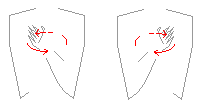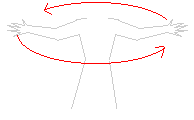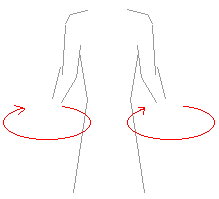How to Dance Gothic
By Kai MacTane and Antigone
Illustrations by Antigone
You went out to your local goth club in your black velvet frock coat, your hair teased up bigger and rattier than Edward Scissorhands’, and lace dripping from your wrists and throat. You looked fabulous. But as soon as you got on the dance floor, everyone started laughing — eventually, they had to toss you out of the club for being “deleterious to the proper level of angst.”
You need to learn to dance gothic.
It’s not that hard; just learn these simple moves and soon you can blend in with all the other spooky individuals on the dance floor at your local batcave. After all, for such an individualistic crowd, it’s kind of surprising how goths all seem to use the same moves. Maybe it’s something encoded in the Goth Genes™ rather than just lack of originality...
All difficulties and Goth Ratings are on a scale of one (pathetically easy or ridiculously non-gothic) to five (tragically difficult or stylishly über-gothic).
|
Difficulty:     
Goth Rating:      |
|
This one is much like Washing the Windows, but with two differences. Instead of facing your palms away from you, you hold your hands with the palms facing each other, a little closer than shoulder width.  Then, instead of moving them in vertical circles, you spiral your hands around each other in a horizontal circle, parallel with the floor. It’s a little trickier, because you have to drop one hand under the other to keep from smacking your forearms together, but you don’t want to make it too obvious — your hands should just spiral lazily around each other with no apparent effort. Then, instead of moving them in vertical circles, you spiral your hands around each other in a horizontal circle, parallel with the floor. It’s a little trickier, because you have to drop one hand under the other to keep from smacking your forearms together, but you don’t want to make it too obvious — your hands should just spiral lazily around each other with no apparent effort.
In fact, “no apparent effort” is a good phrase to describe all these moves. Goth dancing isn’t really energetic; the idea is to be slow, graceful and languorous.
|
Interlude:
So far, you’ve gotten a bunch of moves with the hands. “What about my feet?” you may be wondering. “Where are the little footprint diagrams?” The answer is, there are very few of those here. There don’t need to be very many. Goth dancing doesn’t generally rely on fancy footwork, for a variety of reasons:
- Many goth women wear long skirts and dresses, flowing gowns, and other Victorianesque garments that practically brush the floor. Any fancy footwork they did on those would be invisible. Sometimes, it’s hard to tell if those people even have feet.
- Many goths, both male and female, wear extremely pointy shoes, sometimes with a lift to the heels. These things are designed for looks, not traction or comfort. When your heels are wobbling and your toes are pinched, you don’t tend to do much fancy stepping.
- Alcohol and yes, drugs, are still a part of the goth subculture. It has occasionally been noted that sometimes the dancers simply stand and sway (the move known as “I Am a Frond of Seaweed”) because that may be all they are capable of at the time.
But there are a few goth foot maneuvers, which can be a very important and valuable addition to your gothic dancing. However, if you’re the “two left feet” type, or your own feet hurt, you can just move your feet in random patterns in time with the beat, and everything will be fine.
|
Difficulty:     
Goth Rating:      |
|
 Stand with one foot pointing directly forward and the other behind it, angled out at about 45 degrees, as in the illustration to the left. A little more than half of your weight should be on your rear foot. Now lift up onto the balls of your feet. In time with the music, lift your front foot and daintily place it a bit farther away from your body — you’ll need to bend your rear knee quite a bit while straightening the front leg. Stand with one foot pointing directly forward and the other behind it, angled out at about 45 degrees, as in the illustration to the left. A little more than half of your weight should be on your rear foot. Now lift up onto the balls of your feet. In time with the music, lift your front foot and daintily place it a bit farther away from your body — you’ll need to bend your rear knee quite a bit while straightening the front leg.
 On the next beat, lean forward, transferring your weight to your front foot. Then move the rear foot past the front one, pivoting 45 degrees on the ball of your foot as you do so. This should put you in the exact mirror of the position you were in a moment ago. As you can see in the illustration at right, the foot-pivot happens simultaneously with moving your other foot. On the next beat, lean forward, transferring your weight to your front foot. Then move the rear foot past the front one, pivoting 45 degrees on the ball of your foot as you do so. This should put you in the exact mirror of the position you were in a moment ago. As you can see in the illustration at right, the foot-pivot happens simultaneously with moving your other foot.
“Wow, I could just walk all the way across the floor like this!” you think to yourself. Don’t do it. Take two steps total, maybe three, then reverse it and go backwards. Real goths never use this move to make any real progress; they just go back and forth with it.
This is a good one to practice at home before you try it out on a public dance floor in front of dozens of goths who will mock you mercilessly if you accidentally fall on your face when you mess up. On the other hand, public mocking is great for racking up angst points.   
|
|
Difficulty:     
Goth Rating:      |
|
 Put your arms out to both sides, like you’re being crucified or something. As you do, swirl around once or twice, but remember to do it slowly, not quick like a little kid trying to get dizzy. If you do it right, this one can have some of the feel of time wheeling onward, the spin of the earth around the sun, and so on. It can also come in handy in case some weirdo DJ puts on Dead or Alive’s “You Spin Me Right Round, Baby”. (“Right ’round like a record, baby, right ’round, ’round, ’round.” Oh, yeah.) Put your arms out to both sides, like you’re being crucified or something. As you do, swirl around once or twice, but remember to do it slowly, not quick like a little kid trying to get dizzy. If you do it right, this one can have some of the feel of time wheeling onward, the spin of the earth around the sun, and so on. It can also come in handy in case some weirdo DJ puts on Dead or Alive’s “You Spin Me Right Round, Baby”. (“Right ’round like a record, baby, right ’round, ’round, ’round.” Oh, yeah.)
Variations: This is one the most personalizable of all the moves here. You don’t even need to put both arms out; you can keep one in front of your body (ready to do some other move), or put it behind your back, or you can put it up to your forehead to show how angst-ridden you truly are.
|
Of course, simply knowing these moves isn’t all there is to dancing gothic-style. While you’re practicing the moves at home, you’ll probably also want to practice stringing them together, so you don’t look like you’re doing one move in complete isolation, then doing another with no connection to it.
One other benefit of learning these moves — and their names — is that you can have hours of fun being a gothic dance critic, rating your friends (and social rivals) on how well they perform, say, “Sweeping the Floor”. And consider the scathing put-downs:
| Morticia:
|
“I think Simon’s dancing is just wonderful, don’t you?”
|
| Vlad:
|
“He changes the lightbulb far too often, and he just can’t seem to figure out how to sweep the floor properly.”
|
Kai MacTane has been webmastering the GothPunk.com(Munity) for six years now. People often compliment his dancing. Antigone personally prefers to dance punk, but she draws good stick figures.
Back to 
 It helps if you make slight wavy motions with your fingers while you’re doing this one. These motions need to be slow, however — you don’t want it to look like you’re waving bye-bye; you want it to look like your fingers are gently weaving in an almost hypnotic pattern. Don’t move your circles independently — that just winds up looking silly.
It helps if you make slight wavy motions with your fingers while you’re doing this one. These motions need to be slow, however — you don’t want it to look like you’re waving bye-bye; you want it to look like your fingers are gently weaving in an almost hypnotic pattern. Don’t move your circles independently — that just winds up looking silly.
 Then, instead of moving them in vertical circles, you spiral your hands around each other in a horizontal circle, parallel with the floor. It’s a little trickier, because you have to drop one hand under the other to keep from smacking your forearms together, but you don’t want to make it too obvious — your hands should just spiral lazily around each other with no apparent effort.
Then, instead of moving them in vertical circles, you spiral your hands around each other in a horizontal circle, parallel with the floor. It’s a little trickier, because you have to drop one hand under the other to keep from smacking your forearms together, but you don’t want to make it too obvious — your hands should just spiral lazily around each other with no apparent effort.
 Put your arms outward and down at about a 45-degree angle from your body, with your hands around the level of your hips and the palms facing the floor with fingers spread. Don’t lock your elbows. Now, make horizontal circles with your hands, parallel to the floor. Unlike
Put your arms outward and down at about a 45-degree angle from your body, with your hands around the level of your hips and the palms facing the floor with fingers spread. Don’t lock your elbows. Now, make horizontal circles with your hands, parallel to the floor. Unlike  In many ways the signature gothic dance move, this one is so simple, even a corpse could do it. You just fold your forearms over each other in an X shape across your chest, like you were a corpse in its coffin. You’ve seen Bela Lugosi do this hundreds of times, just before he sits up and says "Good eeeeeve-ning."
In many ways the signature gothic dance move, this one is so simple, even a corpse could do it. You just fold your forearms over each other in an X shape across your chest, like you were a corpse in its coffin. You’ve seen Bela Lugosi do this hundreds of times, just before he sits up and says "Good eeeeeve-ning."
 Stand with one foot pointing directly forward and the other behind it, angled out at about 45 degrees, as in the illustration to the left. A little more than half of your weight should be on your rear foot. Now lift up onto the balls of your feet. In time with the music, lift your front foot and daintily place it a bit farther away from your body — you’ll need to bend your rear knee quite a bit while straightening the front leg.
Stand with one foot pointing directly forward and the other behind it, angled out at about 45 degrees, as in the illustration to the left. A little more than half of your weight should be on your rear foot. Now lift up onto the balls of your feet. In time with the music, lift your front foot and daintily place it a bit farther away from your body — you’ll need to bend your rear knee quite a bit while straightening the front leg.
 On the next beat, lean forward, transferring your weight to your front foot. Then move the rear foot past the front one, pivoting 45 degrees on the ball of your foot as you do so. This should put you in the exact mirror of the position you were in a moment ago. As you can see in the illustration at right, the foot-pivot happens simultaneously with moving your other foot.
On the next beat, lean forward, transferring your weight to your front foot. Then move the rear foot past the front one, pivoting 45 degrees on the ball of your foot as you do so. This should put you in the exact mirror of the position you were in a moment ago. As you can see in the illustration at right, the foot-pivot happens simultaneously with moving your other foot.
 Put your arms out to both sides, like you’re being crucified or something. As you do, swirl around once or twice, but remember to do it slowly, not quick like a little kid trying to get dizzy. If you do it right, this one can have some of the feel of time wheeling onward, the spin of the earth around the sun, and so on. It can also come in handy in case some weirdo DJ puts on Dead or Alive’s “You Spin Me Right Round, Baby”. (“Right ’round like a record, baby, right ’round, ’round, ’round.” Oh, yeah.)
Put your arms out to both sides, like you’re being crucified or something. As you do, swirl around once or twice, but remember to do it slowly, not quick like a little kid trying to get dizzy. If you do it right, this one can have some of the feel of time wheeling onward, the spin of the earth around the sun, and so on. It can also come in handy in case some weirdo DJ puts on Dead or Alive’s “You Spin Me Right Round, Baby”. (“Right ’round like a record, baby, right ’round, ’round, ’round.” Oh, yeah.)